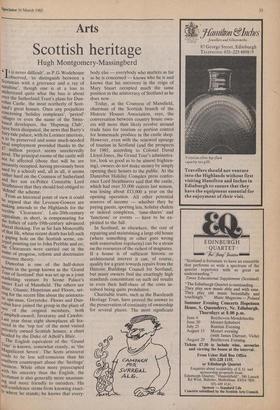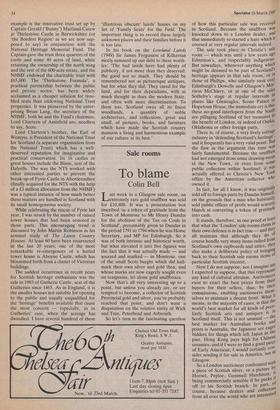Arts
Scottish heritage
Hugh Montgomery-Massingberd
4It is never difficult', as P.G.Wodehouse observed, 'to distinguish between a Scotsman with a grievance and a ray of sunshine', though one is at a loss to understand quite what the fuss is about over the Sutherland Trust's plans for Dun- robin Castle, the most northerly of Scot- land's great houses. Once any prejudices concerning 'holiday complexes', 'period' villages or even the name of the Swiss- based developers, the Ilapimag Club', have been dissipated, the news that Barry's fairy-tale palace, with its Lorimer interiors, is to be preserved and some much-needed local employment provided thanks to the f7 million project seems unrelievedly good. The principal rooms of the castle will not be affected (those that will be are Presently occupied, having previously been used by a school) and, all in all, it seems rather hard on the Countess of Sutherland and her son ex-Police Constable Lord Strathnaver that they should feel obliged to 'defend the scheme. From an historical point of view it could ue argued that the Leveson-Gowers are making amends to the Highlands for the terrible 'Clearances'. Late-20th-century caPitalism, in short, is compensating for !.he follies of early-19th-century advanced liberal thinking. For as Sir lain Moncreiffe °f that Ilk, whose recent death has left such a, gaping hole on the Scottish scene, en- J°Yed pointing out to John Prebble and co, the Clearances were carried out in the flame of progress, reform and doctrinaire economic theory. Dunrobin is one of the half-dozen ,nouses in the group known as the 'Grand lour of Scotland' that was set up as a joint marketing venture by Scone Palace's Owner Earl of Mansfield. The others are !/; lair, Glamis, Hopetoun and Floors, set- "ng for the recent film about the aristocra- tic aPe-man, Greystoke. Floors and Dun- r°bin have joined the group in the place of t,v`10 of the original members, both amPbell-owned, Inveraray and Cawdor. ;.ast year these eight showplaces all fea- `ured in the lop ten' of the most visited Privately owned Scottish houses, a chart headed by the Duke of Atholl's Blair. The English equivalent of the 'Grand Tour' is known, somewhat crassly, as 'the Magnificent Seven'. The Scots aristocrat tends to be less self-conscious than his southern counterpart about the 'heritage' business. While often more preoccupied with his ancestry than the English, the S. cotsman is also generally more unassum- ing and more friendly to outsiders. His self-confidence stems from knowing exact- IY where he stands; he knows that every- body else — everybody who matters as far as he is concerned — knows who he is and knows that his ancestors in the reign of Mary Stuart occupied much the same position in the aristocracy of Scotland as he does now.
Today, as the Countess of Mansfield, chairman of the Scottish branch of the Historic Houses Association, says, the conversation between country house own- ers will more than likely revolve around trade fairs for tourism or portion control for homemade produce in the castle shop. However, even with the renewed upsurge of tourism in Scotland (and the prospects for 1985, according to Colonel David Lloyd-Jones, the Grand Tour's administra- tor, look so good as to be almost frighten- ing), owners do not make money by simply opening their houses to the public. At the Dunrobin Holiday Complex press confer- ence Lord Strathnaver said that the castle, which had over 33,000 visitors last season, was losing about £13,000 a year on the opening operation. All other potential sources of income — whether they be paying guests, sporting lets, holiday chalets or indeed complexes, `time-shares' and 'functions' or events — have to be ex- ploited to the full. In Scotland, as elsewhere, the cost of repairing and maintaining a large old house (where something or other goes wrong with remorseless regularity) can be a strain on the resources of the richest of magnates. If a house is of sufficient historic or architectural interest it can, of course, qualify for a grant towards repairs from the Historic Buildings Council for Scotland, but many owners find the exactingly high standards concomitant on such aid results in even their half-share of the costs in- volved being quite prohibitive.
Charitable trusts, such as the Buccleuch Heritage Trust, have proved the answer to the preservation of continuity of ownership for several places. The most significant example is the innovative trust set up by Captain Gerald (`Bunny') Maitland-Carew at Thirlestone Castle in Berwickshire (or 'the Borders Region' as we are now sup- posed to say) in conjunction with the National Heritage Memorial Fund. The Captain gave the trust three quarters of the castle and some 40 acres of land, while retaining the ownership of the north wing and the rest of the 600-acre estate, and the NHMF endowed the charitable trust with £65,000. The `Thirlestone Formula', a practical partnership between the public and private sector, has been widely acclaimed as a cheaper solution for trou- bled seats than endowing National Trust properties. It was pioneered by the enter- prising Brian Lang, the secretary of the NHMF; both he and the Fund's chairman, Lord Charteris of Amisfield are, needless to say, Scots.
Lord Charteris's brother, the Earl of Wemyss, is President of the National Trust for Scotland (a separate organisation from the National Trust) which has a well- deserved reputation for imaginative and practical conservation. Its 16 castles or great houses include the Binns, seat of the Dalyells. The way the NTS worked with other interested parties to prevent the break-up of Fyvie Castle in Aberdeenshire (finally acquired for the NTS with the help of a £3 million allocation from the NHMF) was a typical instance of how much better these matters are handled in Scotland with its small homogeneous society.
While celebrating the rescue of Fyvie last year, I was struck by the number of ruined tower houses that had been restored in those parts. This encouraging trend is discussed by John Martin Robinson in his seminal study of The Latest Country Houses. At least 60 have been resurrected in the last 20 years; one of the most remarkable re-emergences of a harled tower house is Aboyne Castle, which has blossomed forth from a cluster of Victorian buildings.
The saddest occurrence in recent years for Scottish heritage enthusiasts was the sale in 1983 of Gutherie Castle, seat of the Gutheries since 1465. As in England, it is the smaller houses not suitable for opening to the public and usually unqualified for the 'heritage' benefits available that cause the most concern — especially, as in Gutheries' case, when the acreage has dwindled. I have several hundred of these 'illustrious obscure' lairds' homes on my list of 'Family Seats' for the Field. The important thing is to record these largely unknown places and their families before it is too late.
In his book on the Lowland Lairds (1949) Sir James Fergusson of Kilkerran nicely summed up our debt to these worth- ies: 'The bad lairds have had plenty of publicity, if not more than they deserved: the good not so much. They should be remembered not as picturesque antiques, but for what they did. They cared for the land, and for their dependants, with as much thought as does the modern State, and often with more discrimination. To them too, Scotland owes all its finest woodlands, a quantity of noble architecture, and collections, great and small, of pictures, books, and furniture which have made the Scottish country mansion a living and harmonious example of our culture at its best.'



















































 Previous page
Previous page